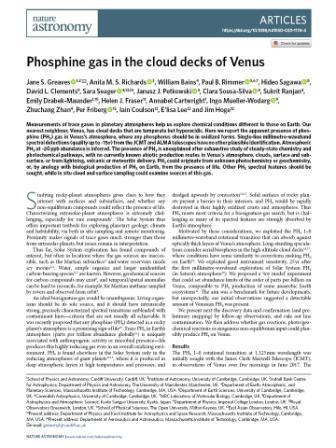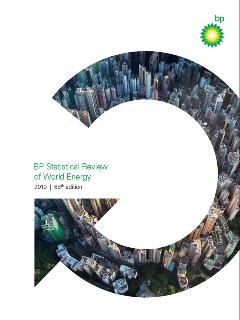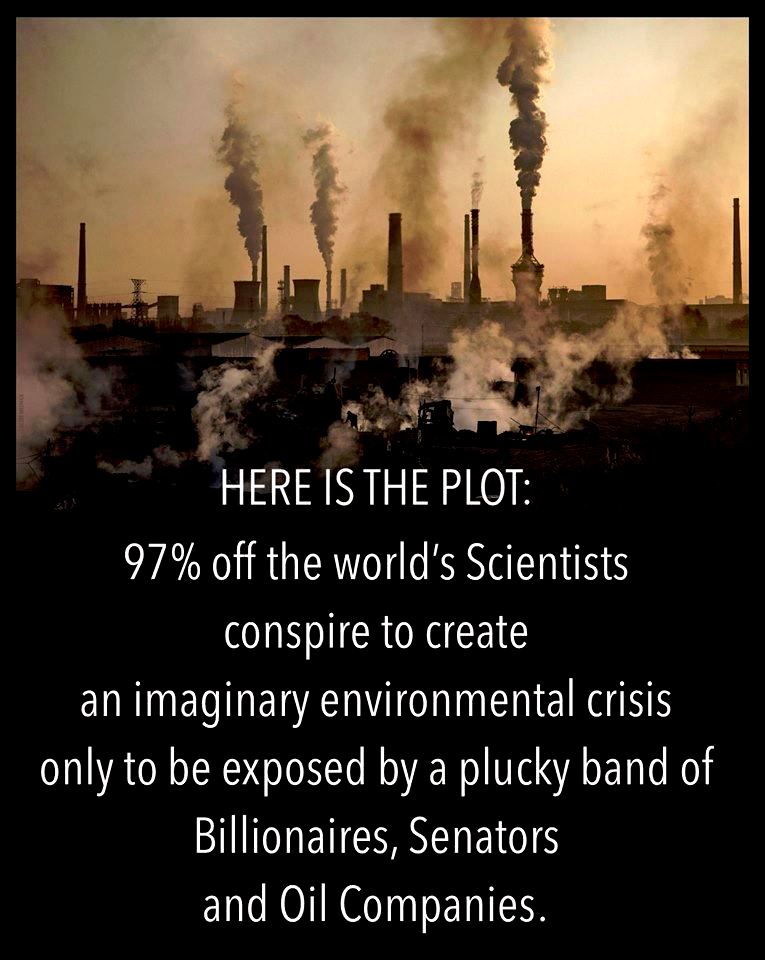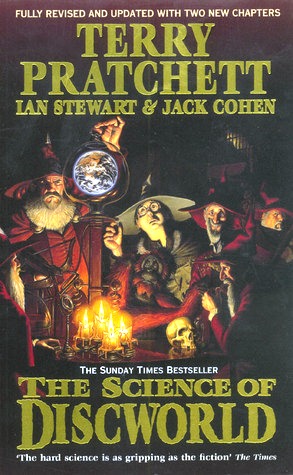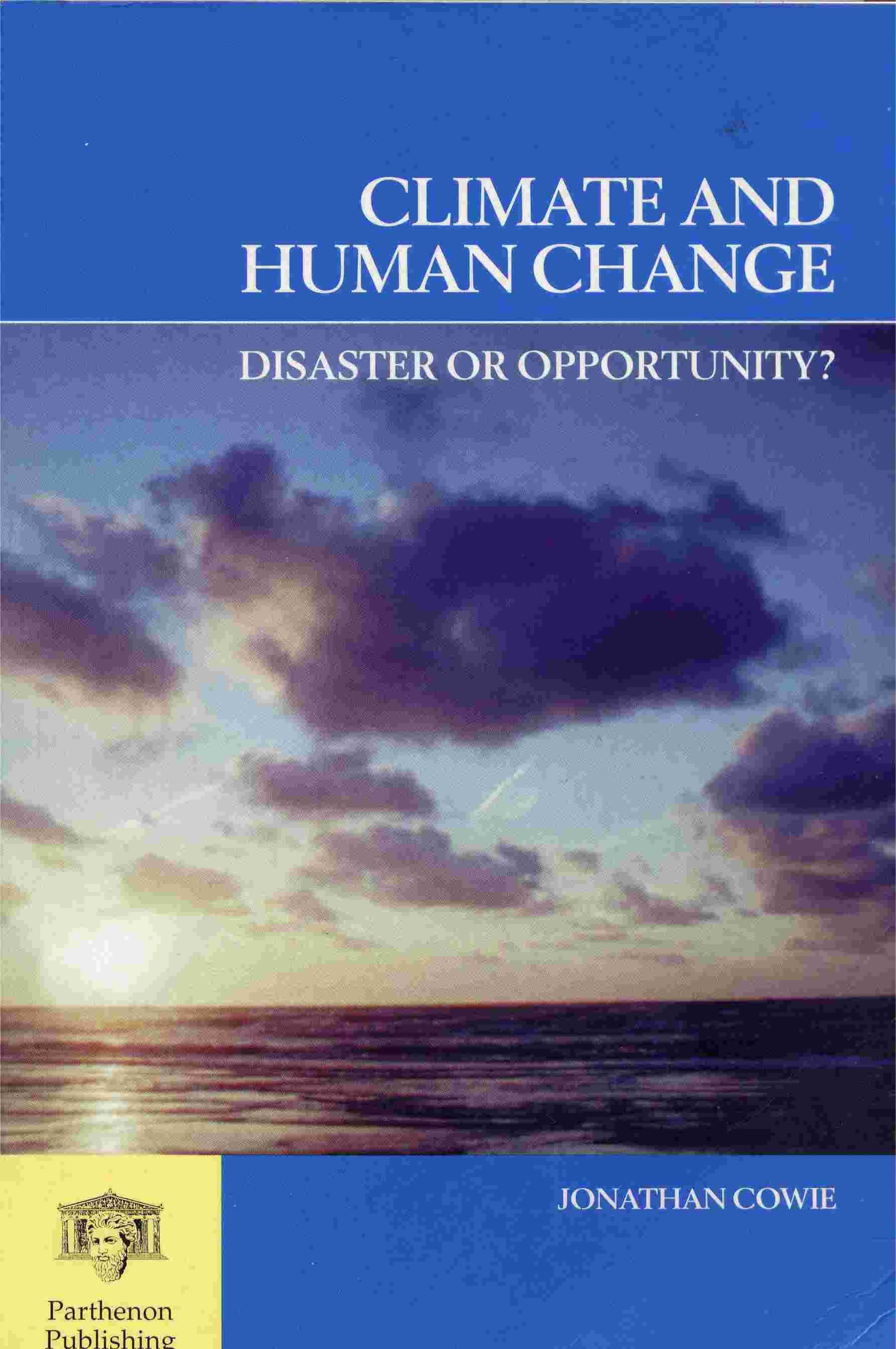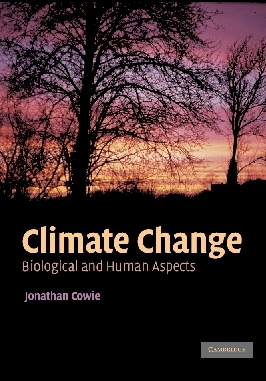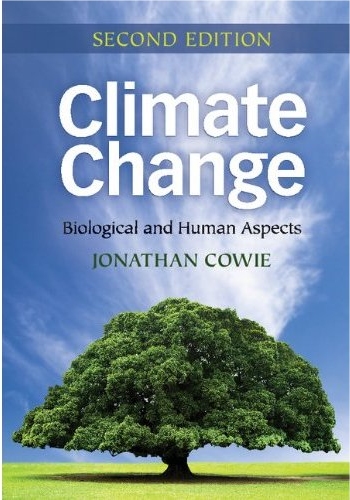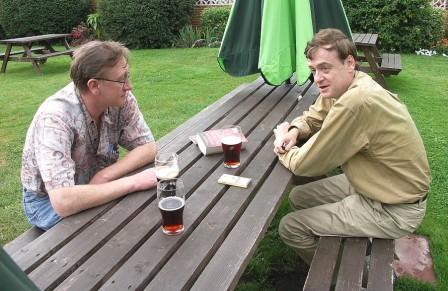|
 Coronavirus under a transmission electron microscope.
Coronavirus under a transmission electron microscope.
|
Concatenation Science Communication
Past news 2019/20
CoVID-19 / SARS-CoV-2 Lockdown -- Please Note Both Science Com and SF² Concatenation are in digital lockdown, but much is continuing as usual. So stakeholders and those who liaise with either should note the following carefully.
Prior to CoVID-19 / SARS-CoV-2, neither abode being connected to the internet was not a problem (not even required) as regular internet access was available at college, volunteer work offices as well as learned society Fellows rooms' and public libraries' cybercafes (plus even hotels when travelling). However, with SARS-CoV-2, access to these has ceased. This means no e-mail communication since 20th March 2020 and this will not resume until we get a vaccine and restrictions are lifted. Sorry, it's age-related shielding from the virus. So if you have e-mailed, now you know why you have not had a response.
All other (non-e-mail) communications are working fine.
Further information below, depending on who you are.
|
|
Book publishers can continue to send review copies to the usual address. (The alternate address has a post office re-direct and there is a weekly, physical back-up check in case anything slips through the net.) SF² Concatenation book reviewers are still being liaised with. (They are being snail-mailed books-received lists together with back cover blurbs for them to select titles for review, and they are sending in their reviews on USB memory sticks or CDs.) So publishers, please continue as usual. There will be SF² Concatenation's usual seasonal academic year spring, summer and autumnal editions unless there is a second pandemic spike and the prohibition of dual household bubbles. (The only changes are the between-seasonal editions 'Best of' Nature 'Futures' short stories which for 2020 are being rolled into the main seasonal editions. For 2021 these will possibly be dropped until e-mail access resumes so that author copyright permissions can be arranged.) The three annual seasonal editions of SF² Concatenation are prepared in advance offline and, once prepared, then uploaded as quickly as possible following some social distancing gymnastics within household bubbles.
Press liaison and other. This has ceased and will only resume once lockdown ends. In any case, all physical volunteer genre events and academic symposia have been cancelled, and learned society premises have been closed to all but key secretariat staff.
Volunteer work. None is being undertaken and will not be until lockdown ends.
All of which provides time for study and writing. (Thank goodness for print subscriptions to primary research journals and learned society magazines.) So that's a win.
Ending the digital lockdown will most likely only happen with a vaccine. As those of you who follow it will know, the primary research is rather promising. (There are loads of pharmaceutical and vaccine, biochemical targets being explored.) While a vaccine by Christmas is possible, it is not exactly a likelihood. Ending lockdown some time in the first half (hopefully) of 2021 is more realistic a prospect.
You are all now probably clued up as to the science behind this pandemic. However, back in the spring (mid-March 2020) I provided a short briefing for the genre community (as the genre diary for the year back then still had physical events planned). Months on, it wears surprisingly well. If interested, you can find it here:-
www.concatenation.org/science/SARS-CoV-2-CoVID-19.html.
Meanwhile, keep distant. Keep safe.
|
|
Greaves, J. S., Richards, A. M. S., Bains, W. et al (2020) Phosphine gas in the cloud decks of Venus. Nature Astronomy. doi.org/10.1038/s41550-020-1174-4.
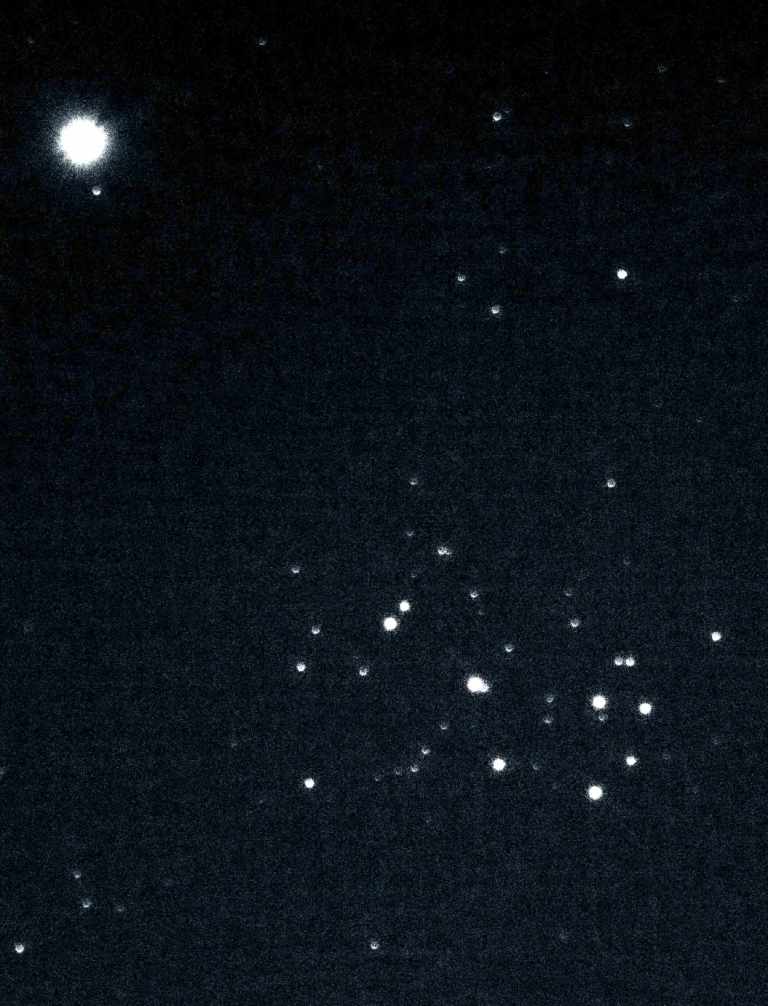 © Ian Moss, 2020. Reproduced here with permission. Venus (top left) and the Pleiades open cluster (bottom right) as viewed in April 2020 from north London using a Nikon D3300 DSLR with Tamron 80-300mm zoom lens set at 170mm.
© Ian Moss, 2020. Reproduced here with permission. Venus (top left) and the Pleiades open cluster (bottom right) as viewed in April 2020 from north London using a Nikon D3300 DSLR with Tamron 80-300mm zoom lens set at 170mm.Venus is, of course, the next planet from the Earth in towards the Sun.
The Pleiades is an open cluster of some 200 stars (only the brightest of which are revealed here) 14 light years in diameter and located 410 light years from London.
Nobody knows if there are analogues to Earth's prokaryotes somewhere in the Pleiades. If there are indeed microbes in the Venusian atmosphere then the odds are that there is also microbial life somewhere in the Pleiades.
Either way, it's a nice astronomical sight.
 © JAXA. Reproduced here under non-comercial use requirement. Venus' night side in the infra red.
© JAXA. Reproduced here under non-comercial use requirement. Venus' night side in the infra red. |
Autumn 2020 Possible biosignature of life on Venus detected. The paper in Nature Astronomy came as something of a surprise. It is the result of a collaboration researchers based at a dozen British research centres. What they have done is detect the radio spectrum of phosphine (PH3) in the clouds of Venus. This comes just after I spent part of the summer reviewing the likelihood of life elsewhere in the Solar System.
Venus is not a nice place; it isn't even a nice place just to visit briefly. Its surface temperature is 462°C and atmospheric pressure 93 times that of Earth's. The atmosphere itself is mainly carbon dioxide (96%) but there are traces of sulphur dioxide (150 parts per million (ppm)) and even less water (20 ppm). Which in turn, under sunlight (photolysis of water and sulphur dioxide), generates sulphuric acid clouds in the upper atmosphere.
The researchers detected phosphine in the atmosphere at an altitude of 33 - 38 miles (53 - 61 km) where it is more clement (30°C and half an Earth atmospheric pressure). The phosphine should react with the Venusian atmosphere and so be removed, but the detection indicates a concentration of 20 parts per billion: something is replenishing it. Atmospheric chemistry has been considered, but the energetics are not favourable. So unless there is some unknown atmospheric chemistry at work, life seems to be the answer. On Earth, some anaerobic prokaryotes do generate phosphine. Could it be that there are analogues of prokaryotes on Venus living in its clouds and this phosphine is part of its biosignature? This is the conjecture.
As said, I spent part of the summer reviewing the likelihood of life elsewhere in the Solar System as part of a current project developing a co-evolution of life and planet narrative. I had included the possibility of microbiological life in Venus's clouds as others previously have (including Carl Sagan, so if it is good enough for him...). However, I have to confess I was rather dismissive as with atmospheric circulation any life would be continually flushed down into less hospitable zones. So it would either need to be extremely hardy, or alternatively there is some layered atmospheric circulation that keeps most of the air away from the hostile surface layers. Yet this new discovery is, I confess, rather enticing, though alternative explanations need to continue to be explored.
While I was rather dismissive of extant life on Venus, according to the co-evolution of life and planet narrative being developed, it is possible that life got going billions of years ago. The idea is this, Venus was far more clement billions of years ago for a period of a little over half a billion years after the late heavy bombardment. Back then, the Sun was a lot cooler than it is today (as it evolved through its main sequence stage). It was only when the Sun got warmer, and Venus being closer to it than the Earth, that the runaway greenhouse effect began to transform the planet into the inhospitable place it is today. This process itself would have taken many millions of years, during which any putative, analogue prokaryote would have had time to adapt.
I am intrigued, though not yet entirely convinced, of the notion of extant Venusian life. I can see it being worthwhile having a mission to skim the planet's upper atmosphere, though I'd want any samples taken to be extremely (and I really do mean 'extremely') biosecure.
Stop press: A year later (2021) a new paper looked at the trace level of water in Venus's atmosphere and concluded that there was not enough for life. So it does look like the phosphine question might be moot. A direct analysis of the atmosphere would help settle matters. (See Hallsworth, J. E., et al (2021) Water activity in Venus’s uninhabitable clouds and other planetary atmospheres. Nature Astronomy. doi.org/10.1038/s41550-021-01391-3.)
|
|
|
Autumn 2020 The vaccines are coming. Recent weeks have seen a slew of papers in the likes of Science and Nature as a number of SARS-CoV-2 / CoVID-19 vaccines are being trialled. It all seems fairly positive. Noting that these papers were submitted a few months ago following writing, it is safe to say that the vaccine development must have progressed a lot since. It could be that we will in a few months time have a viable vaccine if not a few from which to choose.
Could it be that there is a glimmer of light at the end of the tunnel? Let's hope so (otherwise we're in a cave).
|
|
|
Summer 2020 Major breakthrough using kitchen sink science. There are some research papers that are a delight to read and here, sometimes, it is the way they are conducted: not using samples from far flung and hard to get at places in the field, back of beyond, but easy to hand and positively mundane sources. One such past piece of research was Losee L. Ling and colleagues development of cultivating bacterial strains in situ, a grassy field in Maine, leading to a new class of antibiotics: Teixobactin. (Ling, L. L. et al (2015) A new antibiotic kills pathogens without detectable resistance. Nature, vol. 517, p455-9). Brilliant.
The latest such breakthrough is also microbiological and is quite a big deal even if it may not seem much to you: it made the cover of Nature! It concerns a microbe that derives its energy from minerals. (What is known as chemolithoautotrophy.) And so generates manganese oxide nodules.
Manganese (Mn) is quite a common element in the Earth's crust and it has long been known that the reduction of Mn(IV) oxides to Mn(II) carbonates provides energy for some anaerobic chemolithoautotrophs (a chemoautotroph that gets its energy from inorganic chemicals in rock).
|
|
|
All well and good, but around two billion years ago the Earth's reducing atmosphere changed from an anaerobic reducing one to that containing a couple of percent oxygen. Oxygen is a real powerful oxidiser (an oxidiser being something with the propensity to grab electrons from atoms or molecules) and indeed the oxidation of carbon compounds with oxygen enables big animals like you be real active and boogie.
So for some decades it has been contemplated that a reverse reaction using oxygen to oxidise Mn(II) carbonates to Mn(IV) oxides could be employed by some microbes harnessing energy for their metabolic processes: the theoretical energy calculations work fine, but no such chemolithoautotrophs had been found... Until now that is!
Hang Yu and Jared Leadbetter of California's Institute of Technology have isolated such a microbe (Yu, H. & Leadbetter, J. R. (2020) Bacterial chemolithoautrophy via manganese oxidation. Nature, vol. 583, p453-8). But where did they find it: an abyssal thermal vent out of manganese rich strata, or in a microbiome, deep in remote tropical rain forest, or on some distant, inaccessible manganese geological formation? Nope. They got theirs from Pasadena's standard, municipal tap water!
Fantastic stuff. I could not fit this in to the co-evolution of life and planet narrative I am currently developing, as its word count has ballooned. Nonetheless, I simply had to share.
|
 Mars by Viking. © NASA. Non-commercial use here in the context of a review.
Mars by Viking. © NASA. Non-commercial use here in the context of a review.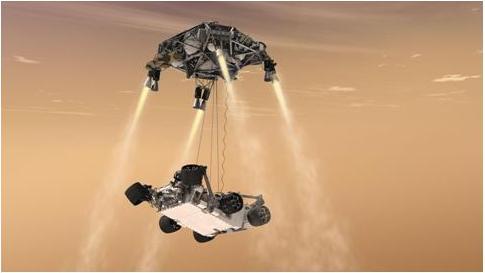 Perseverance. © NASA. Non-commercial use here in the context of a review.
Perseverance. © NASA. Non-commercial use here in the context of a review. |
Summer 2020 And everyone seems to be off to Mars. Probes and landers have been sent to Mars by the United Arab Emirates, China and the USA.
All well and good, and there will be much fascinating science arising out of these missions including, possibly, evidence as to possible past life on Mars or even extant. However, at the same time there are plans to send humans to Mars, and this is really worrying. If there is the possibility of extant life on Mars (and remember we have both seasonal methane and trace oxygen detected in the Martian atmosphere) then do we really want some engineers wandering around that planet's surface, especially as they have been sent by Simp party politicians whose motives are far more to do with prestige than science? Send humans to the Martian surface and not long after they land they'll want to go to the loo, and inevitably have a dump. If they don't bag their waste and bring it home with them then it will signify that British public parks have better hygiene regulations for dogs than there are for humans on Mars. (Owners failing to bag their pet's excrement and take it home is illegal in Britain.)
I have raised this Mars biological contamination concern before in the journal Nature on the occasion of H. G. Wells' War of the Worlds' 120th anniversary. I for one do not want anyone contaminating my biological samples!
If proof of concept for human interplanetary travel is a goal then by all means go to Martian orbit without landing. Humans in Martian orbit can remotely control sterile robots on the surface in real time (as opposed to the significant time lag due to speed-of-light radio delay between Earth and Mars). They can also explore Mars' two moons and remotely retrieve Martian surface rock samples collected by rovers.
To paraphrase one Arthur C. Clarke: ‘All these worlds are yours – except Europa and Mars. Attempt no human landings there.’
|
|
My 2007 American extinction musing now proven.
See p160-1 of above.
(p168-171 of the expanded 2013 edition.)
|
Summer 2020 Why did nearly all large American animals go extinct before 13,000 years ago? This has been a bit of a mystery. Go back a couple of decades and the prevailing view was that climate change was the reason: after all, the Earth was coming out of the coldest part of the last glacial roughly 24,000 years ago (ya) and warming to 11,000 years ago to near 20th century temperatures from being on average 5°C cooler (much more nearer the poles, 8°C) than around the first half of the 20th century.
Yet I was not convinced that the glacial-to-interglacial climate change caused this extinction! First, the climatic transition was less than half a degree Celsius per thousand years. Second, the Earth had been through a number of such glacial-to-interglacial transitions the past couple of a million years (Quaternary period) and one or two of these have been at least as marked as the one 24,000-to-11,000 ya. Third, African large animals did not go extinct and yet it too experienced the end-of-glacial climatic transition. There had to be another factor and that factor, I contended, was the arrival of humans on the American continent. (The reason African mega-fauna survived through to today was that it co-evolved with our species.)
It was a bit of a mystery as, a couple of decades ago, it was thought that America was human-free before 13,000 ya. However I was of the view that humans had to be the answer and said so in the (shorter) first edition of Climate Change: Biological & Human Aspects (2007) on page 161.
|
|
|
This summer the mystery has been solved: humans had been on the American continent long before 13,000 ya. So they could have added extra pressure, to the global climate change, that impacted American large animals.
OK, since 2007, in 2015 it was discovered that humans reached South America between 14,500 and 18,500 years ago. Now, two pieces of research point to a far earlier arrival of humans in America. The first is from the Chiquihuite cave in central Mexico in the Astillero Mountains. 1,900 stone tools were discovered that date from 26,500 years ago. However, if humans were there at that time then the question arises as to what happened to them as there had been no convincing genetic evidence or physical evidence before 15,000 years ago? It appears that quite simply the archaeological record seems to be very sparse. But there is other new evidence than the stone tools.
The second research paper just published is an analysis comes from two of the researchers involved with the afore Chiquihuite cave archaeology. They looked at previous research from 42 N. American archaeological sites, dating their occupation and mapping these with palaeoclimate conditions at the time. The researchers also draw on genetic analysis of local native populations. They conclude that humans first arrived in N. America before the last glacial maximum (the peak of the last 'ice age) some 24,000 years ago, possibly as much as 33,000 years ago. This doubles the age most recently had considered as likely for humans arrival in the Americas.
See Ardelean, C. F., Becerra-Valdivia, L., Winther-Pedersen, M. et al (2020) Evidence of human occupation in Mexico around the Last Glacial Maximum. Nature, vol. 584, p87-92 and Becerra-Valdivia, L., & Higham, T. (2020) The timing and effect of the earliest human arrivals in North America. Nature, vol. 584, p93-7 as well as two review pieces Barras, C. (2020) When did people reach the Americas? Cave tools stoke debate. Nature, vol. 583, p670-1 and Gruhn, R. (2020) Evidence grows for early peopling of the Americas. Nature, vol. 583, p47-8.
|
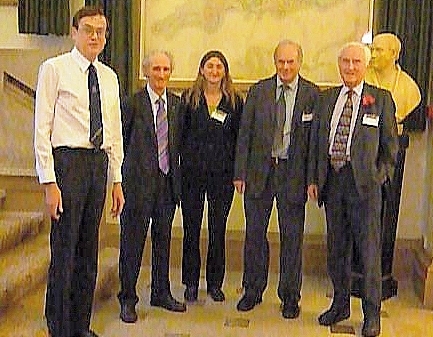 Bob May (2nd from left) in 2010. From left: Jonathan, Bob, Hazel Norman (Secretary Brit Ecol Soc), Bryan Lovell (Geol Soc President), Sir Crispin Tickell (Earth System Science Group).
Bob May (2nd from left) in 2010. From left: Jonathan, Bob, Hazel Norman (Secretary Brit Ecol Soc), Bryan Lovell (Geol Soc President), Sir Crispin Tickell (Earth System Science Group).
|
Summer 2020 Robert (Bob) May FRS CBiol FIBiol passes. I'm now of that age when I'm losing the cohort above me of those for whom I worked. The latest is Bob May. I first worked with him when Sam Berry FRSE CBiol FIBiol (himself now gone) asked me to liaise with Bob who was to guest edit a series in Biologist (back when it was a review journal and not a magazine) called 'Chaos in Biology'. Bob did much to enhance ecology with mathematical approaches: he was a chemical engineer turned physicist turned ecologist. Shortly after that, in 1994 Bob was a leading light of the British Ecological Society (he went on so serve a term as its President) who that year was hosting the International Ecology Congress, INTECOL, and I was handling its press liaison operation and so was introducing reporters to him.
|
|
|
From 1995 to 2000 Bob was Chief Scientific Advisor to the Government which gave him the constitutional right to instigate a meeting with the Prime Minister. Prior to that I had moved from journal management at the Institute of Biology to head up its science policy and so Bob became the first CSA with whom I regularly interacted. He went on to serve a term as President of the Royal Society and, learning of his forthcoming appointment, I urged him to take a look under the carpet of his new office. (Apparently, there is a 'heritage' mosaic left by the building's previous owner. I'll say no more.) I still have from that time a letter from Bob congratulating the Institute on it policy response on genetically modified crop safe separation distances. The last time I saw Bob was when he kindly agreed to speak at a 2010 symposium I was co-convening (see above pic).
As for his science, Bob's passing comes as we are in SARS-CoV-2 lockdown so as to avoid CoVID-19 and the politicians are talking about epidemiologist's Ro. In the late 1980s Bob worked with epidemiologist Roy Anderson and they developed models using Ro that calculate the proportion of the population that needed to be immune be it through vaccine or acquiring herd immunity, for an epidemic to be under control. It is all in their 1991 book Infectious Diseases of Humans: Dynamics and Control. For ecologists, he is noted for his work on biodiversity showing, counter-intuitively, that more diverse ecosystems become less stable unless the new species exploit/access resources differently.
Additionally he worked on climate change and, while he and I agreed on the science, he told me off for being too pessimistic as to the efficacy of early 21st century UK policy to curb emissions. (The numbers speak for themselves and, I contend, still do.)
He also was one of those (especially with John Lawton) who developed the ecotron: a research centre of finely controlled microenvironment capsules that was run by NERC. Other than his time on the UK Committee on Climate Change, perhaps his last major policy contribution was when he and colleagues looked at the 2007/8 banking crisis through the prism of ecosystem stability. Their conclusions were that the interconnectedness of the banking system together with poor level of reserves were key to the crisis. Sadly, in my opinion, the banks and politicians have been resistant to implementing adequate separation of banking sectors warranted by this work's conclusions and so we are not future-proofed against another such event as politicians would have us believe.
What was refreshing about Bob, especially in the world of political spin and Westminster's mealy-mouthed utterances, was his blunt speaking. It has to be said his language was (ahem) colourful and some of us at the Institute would bet on how long into a policy presentation it would be before he dropped an F-bomb. Then one day, suddenly it stopped: we guess someone on high had had a word. Irrespective of this, be it a policy presentation or one at a symposium, Bob's talks were must see. Regarding his time as Chief Scientific Adviser, while one or two have come close, I am not sure that we have had as good a CSA since. Certainly it is lamentable that following the Brown government, the next one (Cameron) swept away the scientific advice guidelines Bob had developed for John Major and Tony Blair. Had they been retained then much of the current confusion as to the science underpinning SARS-CoV-2 / CoVID-19 policy would be clear as May's guidelines called for public transparency and the spectrum of science views being presented together with the range of (un)certainties and boundaries of knowledge.
|
 Cartoon representing how a system can cross a 'threshold' (or 'tipping point') and enter a new state.
Cartoon representing how a system can cross a 'threshold' (or 'tipping point') and enter a new state.
©. Nystrom, M. et al (2019) Anatomy and resilience of the global
production ecosystem. Nature, vol 575, p98-108. Reproduced here in the context of a review.
 Crossing a climate/ecological/Earth system threshold can be considered as the transition between two (climate/ecological/Earth system) states that are mathematically related to a Lorenz attractor between the two states within a chaotic system.
Crossing a climate/ecological/Earth system threshold can be considered as the transition between two (climate/ecological/Earth system) states that are mathematically related to a Lorenz attractor between the two states within a chaotic system. |
Autumn 2019 to Spring 2020 A number of papers from the autumn 2019 to Spring 2020 indicate that we may be pushing the Earth system across a threshold to under go a critical transition. This is something I explored back in 2007 and 2013 in Climate Change: Biological & Human Aspects -- including the section starting page 355 in the 2nd edition. The idea is this, as the planet warms so carbon 'leaks' from ecosystems into the air either as carbon dioxide or methane (both are greenhouse gases) so furthering warming which in turn furthers ecological leakage of carbon.
This 'ecological leakage' (as distinct from 'economic leakage' which is quite different and associated with the fossil carbon inherent in the manufacture of imports) of carbon can happen in a number of ways including the December 2019 to February 2020 Australian wildfires releasing carbon dioxide (with the wildfires themselves being boosted by climate change) and permafrost melt releasing methane. In the context of global climate change, such leakage can push a local across a 'threshold' (or 'tipping point'). For instance, wildfires could become so frequent and warming sufficient to permanently change the local biome and its ecosystems constituent species mix. Or, permafrost melt may not see permanent re-freezing following the next winter seeing the land become more like a bog. The concern is that if enough thresholds are crossed locally, then the Earth system as a whole might cross a global threshold and enter a new state. This might possibly become manifest with positive feedbacks resulting in a sudden release of carbon enhancing our current carbon isotope excursion.
Such recent papers and journal review articles include:-
Trisos, C. H., Merow, C. & Pigot, A. L. (2020) The projected timing of abrupt ecological disruption from climate change. Nature, vol. 580, p496-501, and the review piece Sunday, J. M. (2020) The pace of biodiversity in a warming world. Nature, vol. 580, p460-1.
Hubau, W., Lewis, S. L., Phillips, O. L. et al (2020) Asynchronous carbon sink saturation in African and Amazonian tropical forests. Nature, vol 579, p80-7, with a review piece Rammig, A (2020) Tropical carbon sinks are out of sync. Nature, vol 579, p38-9 and editorial (2020) A warning from the forests of Africa and the Amazon. Nature, vol 579, p7-8.
Lovejoy, T. E. & Carlos Nobre, C. (2019) Amazon tipping point: Last
chance for action. Science Advances, vol. 5, eaba2949.
Nystrom, M. et al (2019) Anatomy and resilience of the global production ecosystem. Nature, vol 575, p98-108. (The global food production system is a forced 'enhancement' of natural systems creating new, unstable -- take away nutrient and energy inputs they would collapse -- states. As an unstable state it is susceptible to perturbation such as by climate change.)
Walker, X. J. et al (2019) Increasing wildfires threaten historic carbon sink of boreal forest soils. Nature, vol 572, p520-3.
Rumpel, C. (2019) Soils linked to climate change. Nature, vol 572, p442-3. (PDF here.)
Turetsky, M. R., et al (2019) Permafrost collapse is accelerating carbon release. Nature, vol 569, p32-4.
|
|
Autumn 2019 The UN has its latest, revised World Population Prospect forecast. The 2019 revision of the World Population Prospects is the twenty-sixth edition of the United Nations population estimates and projections, which have been prepared since 1951 by the Population Division of the Department of Economic and Social Affairs.
The world’s population reached 7.7 billion in mid-2019, having added one billion people since 2007 and two billion since 1994. The global population is expected to reach 8.5 billion
in 2030, 9.7 billion in 2050 and 10.9 billion in 2100, close to peak predicted population. The major population growth areas for the remainder of the century will be Asia and Africa.
|
|
|
|
Autumn 2019 My old office has been transformed! Yours for just £21,450 per month (2019)... or over a quarter of a million a year!
The Institute of Biology used to occupy and own both 20 and 22 Queensberry Place, Kensington. (When I started there in the 1980s we only had 20 Queensberry Place.) In my latter years my office was on the third floor (above ground floor) in number 22. Alas, in a good deal for some (there was a 2003 valuation of both buildings together at just £3.2 million (IoB Annual Report 2003, p22)), the Institute sold its premises in 2004 shortly after I left, and, a few years later still, subsequently changed its name to the Royal Society of Biology and moved into rented accommodation.
|
|
|
Meanwhile both buildings were done up by the new owners and number 20 by itself (half the original IoB premises) was sold in 2010 with a guide price of £12 million as a seven-bedroom end of terrace. 20 Queensberry Place was subsequently turned into flats and 22 kept as a single residence which now (2019) is up for rent for nearly a £21,450 a month (£257,400 a year). This means that the house will make back its £1.6 million (half of £3.2 m) purchase price in a little over six years. Assuming a cool million was spent on doing the building up, the new owners will make their money back on their investment within a decade's worth of rent. After that, it's money in the bank.
The picture below is how my old office looks today. Gone: the science journals, policy documents, symposium proceedings, publication manuscripts and so forth. In: new wallpaper, wooden cupboards, heater coverings, in-ceiling lighting and a seemingly soft bed...
 My old office's new look...
My old office's new look... |
 Carbon dioxide emissions from existing energy use (such as power stations which also are the principal source accounting for over a third of these emissions) between 2018 to 2058. Additionally, currently proposed energy infrastructure (such as fossil fuel power stations planned or under construction) mean that emissions will continue through to 2070.
Carbon dioxide emissions from existing energy use (such as power stations which also are the principal source accounting for over a third of these emissions) between 2018 to 2058. Additionally, currently proposed energy infrastructure (such as fossil fuel power stations planned or under construction) mean that emissions will continue through to 2070.
From: Tong, D., Zhang, Q., Zheng, Y. et al (2019) Committed emissions from existing energy infrastructure jeopardize 1.5 °C climate target. Nature, vol 572, p373-377. Reproduced here © in the context of a review. |
Summer 2019 Existing fossil fuel power plants and other existing energy infrastructure will generate more greenhouse gas in the coming decades than is needed to keep global warming below 1.5 °C.
Even if all new electricity production was to be from renewables and nuclear (non-fossil carbon), and all new trains were electric (not, say, diesel) or all new cars made electric (not petrol driven), then the carbon emissions alone from existing fossil fuel plants etc., over the next four decades will still commit us to a warming of over 1.5 °C -- the UN's 2015 COP21 Paris Accord limit. Add in those fossil fuel power stations, trains etc. currently planned, then we will break the Accord's 2.0 °C fall back, or backstop, limit by 2070.
This is the conclusion of Dan Tong and colleagues, based in the US and China, in a paper published this week in Nature (see caption to the figure left for the reference).
I remind you that back in 2009 I said that (scroll down a little here) 'it seems very likely (without a really major change in global human behaviour) that we will exceed our 'safe' 2°C above pre-industrial level (or 1·2°C above the Earth's 2006/7 temperature) warming'.
Of course, in addition to the fossil fuel power stations currently existing and planned, you can bet your bottom dollar that a decade from now other new proposals for fossil fuel plants will come to be. So, the question now really is how warm will we continue to drive the planet?
A decade on from my 2009 essay, this latest Nature research firmly underlines one of my essay's core conclusions. Of course I do not have a crystal ball but I can hold a number of variables (population, changing energy intensity, fossil fuel consumption, rates of energy system transference etc.) in my mind and calculate the likely near-future broad trends over a few decades. To my mind, the writing was on the wall back in 2009; today, 2019, it is in Nature.
This, therefore, will be one of my last posts linking current research to my 2009 essay: over the past decade I have listed subsequent key research that supported my essay's conclusions: matters have almost run to their inevitable conclusion. However, you do not get off that easily, I will from time to time refer to this essay as we head towards breaking the Paris Accord's limits.
I am tempted to say, as Sheldon Cooper once did, that I will not repeat that 'I told you so', but from now on I might utter, 'I informed you thusly.'
I informed you thusly.
|
|
|
Summer 2019 The IPCC has produced a special report, Climate Change and Land, that is garnering news headlines around the world and much comment. The report is rather good but you do need to carefully read the small print including that we do not have a good global figure of agriculture carbon dioxide emissions (the estimates for methane are a little better). Alas the news headlines (and resulting public debate) are much less robust. It is impossible to provide a detailed analysis here, but the bottom line is 'yes' we do need to cut down on meat consumption. However this does not necessarily mean that the best option is for everyone to go vegan.
A few illustrative points in the context of an overcrowded planet: grassland, permanent pasture animal production produces far less carbon emissions (and grassland itself is a net carbon sink) than grain fed animals; rugged uplands are not suitable for crop cultivation but can be used for grazing livestock; sustainable fishing results in few emissions (compared to some forms of intensive fish farming); and, even if you do go vegan, what about your pet dog or cat? (This last so far is completely missing from the debate, as is the carbon emission heritage people pass on via the number of their offspring.)
The devil is in the detail. Whatever else, carefully read the entire report before coming to a policy stance.
|
 The 2019 SF Worldcon was held in Dublin.
The 2019 SF Worldcon was held in Dublin.
 The entrance sign to Martin Hoare's bar at the 2019 SF Worldcon, Dublin.
The entrance sign to Martin Hoare's bar at the 2019 SF Worldcon, Dublin. Martin Hoare's bar.
Martin Hoare's bar. 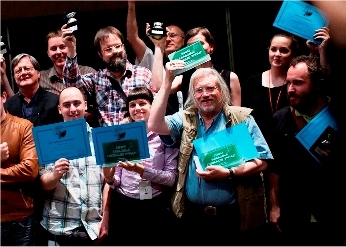 2012 Eurocon winners or their proxies after the presentation ceremony at the 34th Eurocon, Zagreb, Croatia.
Martin Hoare (blue shirt centre right) accepted on our behalf.
2012 Eurocon winners or their proxies after the presentation ceremony at the 34th Eurocon, Zagreb, Croatia.
Martin Hoare (blue shirt centre right) accepted on our behalf.
|
Summer 2019 Despite the overcrowding, the Dublin 2019 Worldcon has, for many, been a great success. (Overcrowding has been a bane of recent European-venued Worldcons including the 2014 Loncon Worldcon (crowding noted here) and Helsinki in 2017.) Though I was not at this year's Worldcon in Dublin (I foresaw the crowding issue), I received numerous messages from it while it was taking place to aid coverage of that event over at our genre wing's SF² Concatenation.
One thoughtful touch by the organisers was to name the convention bar 'Martin's' after Martin Hoare who sadly passed a few weeks before the event. Martin was a longstanding acquaintance of mine (nearly four decades). Indeed, decades ago, it was he who inadvertently added press liaison to my skill set with Seacon '84, the first and to date only combined Eurocon and Eastercon.
Back in 1983 Britain had won the bid to host the then forthcoming annual Eurocon in 1984 and I wrote to Martin who was the convention's Co-Chair saying I hoped that the convention would have a press operation to promote the event specifically and the genre generally. (Back then even large conventions did not have a dedicated press officer.) Martin replied saying that as I seemed to have an idea as to what was needed (I didn't) that I should do it, and so I did. Today the 1984 British Eurocon cum Eastercon (the national British SF event) remains the only Eastercon to have had a full-half hour BBC Radio programme dedicated to it. (It also had a 15 minute mini-programme on the BBC World Service among much other, especially local, media coverage and the press liaison op was written up as Cowie, J. (1984) The 1984 Eurocon Press Report. BECCON Publications: Harold Wood, Essex, UK.)
Over the years I continued to see Martin at conventions including at many Eurocons. Indeed he picked up a Eurocon Award for our SF² Concatenation genre wing in Zagreb, Croatia (2012) when I could not attend that year's gathering.
Martin was the 2019 Dublin Worldcon's fan bar organiser; hence the resolution was made by the convention's board to name in his memory the event's bar after him.
A truly excellent decision.
|
|
|
This picture (below) took over a quarter of a billion years to prepare.
So I hope you truly appreciate it!

Interlude. This is a delta estuary and shallow sea: well, what was an delta or shallow sea some 300 million years ago (mya) in the Carboniferous. This is Curbar Edge and I'm resting on gritstones or millstone grit (coarse grained sandstones) that were formed in a vast river delta on the edge of the palaeocontinent Euramerica: a delta that once covered much of what is now England. In the background (Curbar) the valley floor is predominantly limestone formed, even earlier, in a shallow sea some 350 mya and subsequently (300 mya) covered with shales. The break up of Laurasia, when N. America (Laurentia) began to split from Europe (Fennoscandia), in the late Jurassic (around 150 mya) began some regional uplift which begun to become marked 60 mya. To give you a sense of place in time, this was after the dinosaur K/T (Cretaceous/Tertiary) -- or K/Pg (Cretaceous-Paleogene) if you prefer the new nomenclature -- extinction. So the area began to become land in the run up to the Eocene. (Sea level had its ups and downs prior to that.) On the day this photo was taken, this multi-million year perspective reminded us we still had several hours to go before our sampling, of Anthropocene, microbial excreta of anaerobic respiration waste products from their feeding on squished, vegetative biomass, at a local microbrewery public house. The things one does for science...
Palaeo-Earth perspectives generated by the palaeovisualiser at dinosaurpictures.org.
|
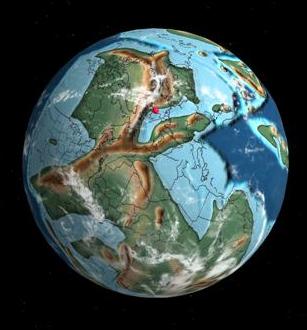 340 million years ago (mya).
340 million years ago (mya). |
 150 mya.
150 mya.
The red spot marks Curbar Edge. |
 66 mya.
66 mya. |
|
|
Meanwhile, back at the plot...
|
|
And, yes, I am aware this contrasts with the previous post below.
|
Summer 2019 The 2019 BP Statistical review of World Energy is now out. While I have in the past had occasion to interact with the BP Economics Unit who used to produce this annual burst of data, that was a third of a century ago and the way they do things now is a little different. For very much the most part, there has been an increase in the amount of data they present and this makes this annual guide (along with a number of other separate data sources) even more useful to those with an interest in climate change and the human ecology of energy use. What's more, it is free to download and very easily located by search engine.
All well and good, but this year I particularly noted BP's Chief Economist's introduction.
"The headline numbers are the rapid growth in energy demand and carbon emissions. Global primary energy grew by 2.9% in 2018 -- the fastest growth since 2010. This occurred despite a modest GDP growth and strengthening energy prices."
At the same time carbon emission from energy grew by 2.0%, again the fastest expansion for many years..."
But it is was this in the context of the Chief Economist's previous introductory section in which he said...
"...there was growing societal awareness and demands for urgent action on climate change, but where the actual energy data continued to move stubbornly in the wrong direction."
A growing mismatch between hopes and reality..."
Two things. First, this is a fossil fuel company saying this and being very responsible. Second, I can't help notice how this chimes with my online essay of a decade ago, Can we beat the climate crunch? and its conclusion to the question Can we avoid this threat of serious warming (and carbon dioxide limit)? (having clicked on the afore link you'll need to scroll down to see the conclusions in brown font).
When fossil fuel companies start agreeing with you I move from worrying to the embryonic stages of panic.
|
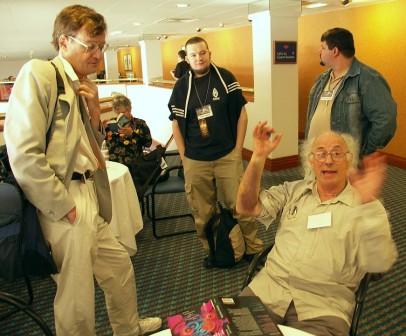 Jonathan & Jack at the 2005 Worldcon, Glasgow, Scotland.
Jonathan & Jack at the 2005 Worldcon, Glasgow, Scotland. |
Summer 2019 Jack Cohen CBiol FIBiol has passed aged 85.
At my 40th birthday bash Jack, unbeknownst to me at the time, decided to take it upon himself to say a few words as the 'only person [there] who knew [me] in both the worlds of biology and that of science fiction'. And so now, belatedly, I return the favour. Jack was a bioscientist into reproductive biology including that of humans. And so for a number of years, based at Birmingham University, his work straddled that of biology and working with clinicians assisting people with fertility-fecundity problems. He was also active within the Institute of Biology (the professional body for British biologists, subsequently rebranded as the Royal Society of Biology). Among other things, he helped draft the Institute's Royal Charter (recently adopted by the RSB). He served a term on the Institute's Council and at least a couple of stints on the Institute's Biomedical Sciences Committee (which as it happened, as in the 1990s and early 2000s I ended up servicing). But, if I recall correctly, I first met Jack at Birmingham's science fiction convention, Novacon 8 (though I was also at Novacon 7 as, I'm sure, was Jack). He had just been on a panel discussing extraterrestrial life, and Jack had been contributing musings on the possible biology thereof. I do recall that I raised a point of disagreement with him in the panel's Q&A session (I lean towards convergent evolution being a tad more significant than Jack) and that this spilled over into a discussion in the corridor with Jack and I trading biological concepts, scientists' works and finally citing academic papers at each other, before both of us simultaneously asking the other, "who are you?" Well, Jack, it transpired, was a university lecturer at Birmingham, and I (then) a mere undergraduate at Hatfield. Anyway, we struck up a friendship and then several years later, when I joined the Institute's secretariat, developed a professional relationship.
|
|
|
Jack was also known beyond bioscience academia and SF circles, both for his occasional appearances on TV as well as his popular science books and, for biologists, his text books. These include: Living Embryos (Pergamon, 1963, 1967, 1980), a classic textbook that sold more than 100,000 copies; Spermatozoa, Antibodies and Infertility (with W. F. Hendry, Blackwell 1978); and The Privileged Ape (Parthenon, 1989) that bravely -- we had only been going a couple of years -- name-checks Concatenation. Jack always (and I truly mean 'always') gave interesting talks and lectures. But I have to confess I wondered how his students coped? (By the way, one of his students was the Nobel Laureate Prof. Sir Paul Nurse FRS.) Jack's lectures were invariably an absolute delight to listen to but afterwards one often wondered what was the take-home message: how would his students revise? As such I always felt that Jack's lectures were a bit like a fireman's hose: providing an extremely powerful delivery but hard to aim. And so I was delighted when, after over three decades at Birmingham U., Jack moved down the road to Warwick where his occasional collaborator, mathematician Ian Stewart FRS, worked. Ian, I think it fair to say, helped provide Jack with some focus and together they wrote some remarkable books notably including: The Collapse of Chaos (Viking/Penguin (1994 and 2000) and Evolving the Alien (Ebury, 2002), it has also been released as What Does a Martian Look Like: the science of extra-terrestrial life (Wiley in the US and the Ebury UK paperback also has that title). (However, Prof. Sir Paul Nurse FRS did send a message, read out at Jack's funeral, saying: 'Jack was an inspirational teacher... Every university department needs one Jack Cohen.')
Jack and Ian also wrote a couple of SF novels set in the 'Wheelers' universe. Yet, with regards to the broader genre-reading public Jack and Ian are best known for their series of books with Terry Pratchett on The Science of Discworld. Having said that, Jack did help provide some biology for SF authors' novels including Larry Niven, Anne McCaffrey's Dragonriders of Pern (that also fed into her, and later Todd's, other 'Dragon' books) as well as Harry Harrison's 'Eden' books.
Jack and I both had an interest in the concept of alien life. It has to be said, as alluded earlier, that here we had our differences: in addition to convergent evolution above, I'm a primacy of water as the principal biological solute man; Jack was more broadminded. However we did agree about a lot, including that in considering alien biology, we need to divide it into two components: that which is part of the universal rules of life, and that which just happens to be peculiar to the biological evolution on that particular planet. So in my early days at the Institute of Biology, when I was its Head of Publications, I asked Jack to write an article for Biologist (back then a broad-based academic journal with a reasonably respectable, mid-level citation index a tad above 3.0) and to which I provided a text box. The article is archived here with permission of Rebecca Cohen (Jack's daughter): Cohen, J. (1991) The possibility of life on
other planets. Biologist 38 (1), 7 - 10.
Jack, ever ebullient, always with an interesting take to hand, delightfully quirky and controversial, you were simply a joy.
Jack's obituary is here in Biologist 66 (4), 46. I had referred to Jack as 'Jack' throughout but the editor changed it to his surname.
|
|
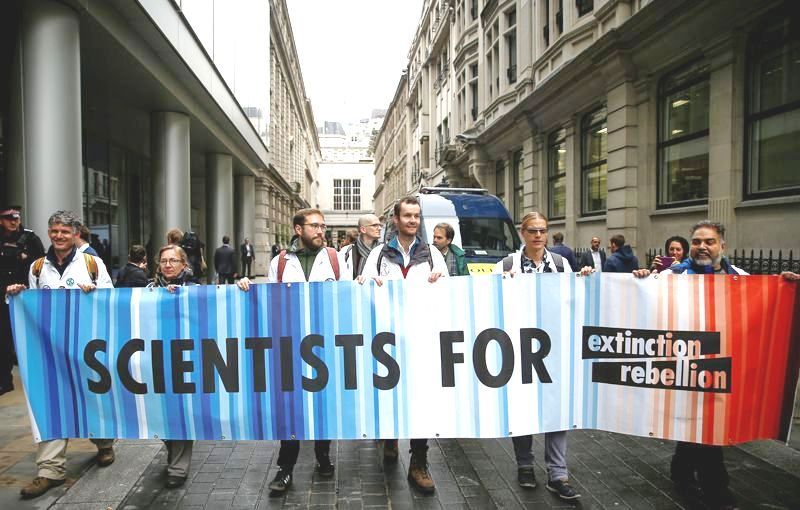 And I'm not alone.
And I'm not alone. |
Spring / Summer 2019 The climate Extinction Rebellion demonstrations take place in London, and the earlier School Strike for Climate in Sweden -- much credit to 16 year-old Greta Thunberg -- as well as Germany, Japan, Britain and Australia and the Extinction Rebellion, all push climate concerns up the political agenda. This gives me a little optimism. I am known to colleagues and friends for my pessimism regarding the trajectory of human, global development: the human ecology prognosis has, for over half a century, not been good. My worries (stemming from school days) were initially brought into greater focus as an undergrad in the 1970s when looking at the methodology of Jay Forrester's World model developed by MIT. It's output not only works backwards from the 1970s to 1900 (any one can be brilliant with the benefit of hindsight), but (for population, resources -- when considered as a proxy for fossil energy -- consumption, and agricultural output) we can now see it had successfully forecasted forward for 40 years!
That's some achievement that no politician or economist or sociology academic that I know of can claim. (Though expect a slow but increasing divergence from the Forrester model's standard run and reality as this century progresses.)
Meanwhile, my own 1990s examination of the energy-use dimension of human ecology for Climate and Human Change: Disaster or Opportunity? (1998) was not reassuring. Nor was I in the early 2000s for my Cambridge U. Press books which led to my 2009 online essay 'Can we beat the climate crunch?' here on this site. This essay itself has seen so far a subsequent decade's worth of others' works provide corroboration.
|
|
Our 20th and early 21st century human ecology regimen is simply not sustainable.
Globally, the political classes have let us down. But the Ghandi-like Climate Extinction demonstrations and the School Strikes for Climate have helped raise the profile of the issue up the political agenda.
Now, while I cannot claim to have played a significant role in either Extinction Rebellion or the School Strikes, my works on climate change have been read by thousands including thousands of university lecturers and school teachers. These lecturers and teachers each in turn have individually taught arguably hundreds of students and school pupils and collectively hundreds of thousands! I therefore hope it is not too immodest of me to think that perhaps I have played a small positive part in all this, even though I remain pessimistic knowing that much, much more is needed.
|
|
A farewell (right) to Graham from the science fiction community.
Graham was included in the 2019 SF Worldcon in memoriam roll to mark those we have lost from the international science fiction community. As is usual, it took place midway through the Hugo Awards ceremony.
|
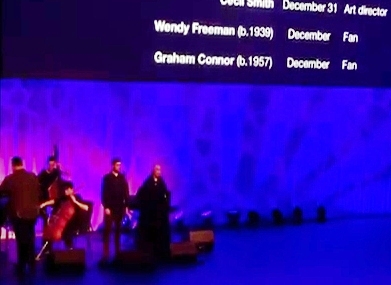 Video here (7 minutes, Graham scrolls at 2 mins, 2 seconds)
Video here (7 minutes, Graham scrolls at 2 mins, 2 seconds).
|
|
It has to be said that this was a bit of a hotchpotch of papers rather than an exposition of a particular science narrative: this event was really a catch-up on some of the areas of current Earth system science research. No problem here as it has been seven years (really, that long!) since the last Earth System's Science Group symposium.
Ground covered included: a major pulse of carbon dioxide contributed to the end-Permian extinction (this chimed with 2018 Mass Extinctions symposium and the 2017 Royal Society Hyperthermals symposia (which I see I failed to blog about previously)); end-Permian mutations possibly caused by heavy metal release or UV light following ozone depletion; the use of 7Li as a proxy for silicate weathering; and that across deep time since the Cambrian the long-term trend in declining extinction rates suggests that the Earth-system is, in long-term terms, becoming increasingly resilient, but that the system is currently in a semi-stable mode (and so now is not a good time to give it a greenhouse kick).
Tyler Volk, visiting from the US, gave an intriguing narrative talk on the evolutionary progression from prokaryotes, to eukaryotes, to multicellular life, to socio-biological groups and the possible forthcoming planet-wide organisational structures. Lee Klinger, again from the US, gave examples of traditional native American, as well as early colonist biological management (bio-conservation) strategies, that we seem to have forgotten but which do confer ecosystem-level resilience.
Sadly President Trump's shutdown of governmental expenditure prevented Douglas Erwin of the Smithsonian giving a plenary on evolution, resilience and stability in the Phanerozoic. (I was looking forward to that.) The Trump-caused uncertainty meant that the symposia's abstract booklet was not produced as a hard copy. Fortunately, meeting secretariat Ruth Davey kindly printed out the PDF for me (a perk of being a Geological Society Fellow?): after all, one needs to make notes annotating the abstracts when attending symposia.
|
 Argo float deployment. (© Cheng et al [see bottom of text right for source] reproduced under fair use in the context of a review .)
Argo float deployment. (© Cheng et al [see bottom of text right for source] reproduced under fair use in the context of a review .) |
Winter 2019 New estimates indicate faster ocean warming. One of the audience questions oft asked in my climate change talks of the early 2010s was how come global warming seems to have stalled? This is because the Climatic Research Unit and the UK Met Office data for warming showed that since the 1998 peak, through to 2013, there was no extra warming. This helped fuel climate deniers' arguments in the 2000s. Actually what was likely happening, as I would point out, was that the aforementioned climate data related to surface temperatures; it ignored the heat within the oceans. We did have some data but it was not as complete as the data gained from surface monitoring. The data is still incomplete (especially for waters below 2 km) but as Lijing Cheng, John Abraham, Zeke Hausfather and Kevin E. Trenberth, have just pointed out, in a perspective paper in the journal Science, we are slowly getting a better handle on ocean temperatures. Part of this improvement in understanding comes from the Argo network of some 3,000 buoys in the early 2000s that measure temperatures in the top 2 km of the oceans.
These have confirmed that the planet's oceans have absorbed about 250 x 1021 joules (250 zettajoules) between 1990 and 2018. This figure is in broad agreement with the latest Earth system computer models. Combining these real-life measurements with the models, suggests that the oceans have absorbed around a third more energy (in terms of watts per square metre) than the IPCC's 2013/4 Assessment Report 5 concluded. Because of thermal expansion of water, this has a considerable impact on sea-level rise projections, which now have to be revised upwards.
This is something I have long-time argued given that the glacial to interglacial sea-level rise (20,000 to 15,000 years ago) was at times up to 3 metres a century, which is far greater (four or five times) than the IPCC worse case forecast estimates for the 21st century. (I mentioned this in my books Climate and Human Change (1998) and Climate Change: Biological & Human Aspects (2013) pages 334-5.) Of course, the greenhouse kick we have given the Earth system, in the 20th century combined with that estimated for the 21st century, is greater than that which naturally occurred in the last glacial-to-interglacial transition. The reason I have not given warning of possible, even greater, sea level rise is because of inertia of the Earth system: it takes time for the system to adjust. Also, I do not want to appear alarmist.
See Cheng, L. et al, 2019, How fast are the oceans warming? Science, vol. 363 (6423), p128-129.
[Past news 2017/18]
[Bioscience interactions | Climate change interactions | Science & Fiction interactions | What is Concatenation all about? | Home ]
|
| |

